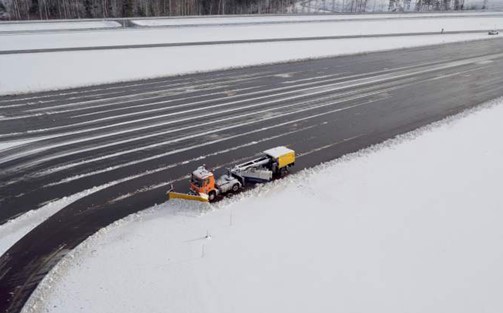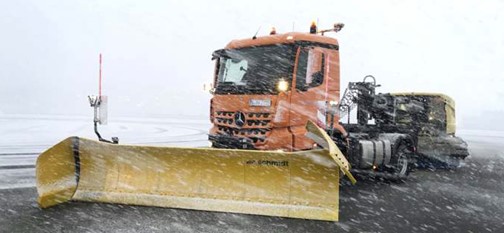With AXYARD, Lab1886 and Daimler Trucks automate the operation of snow-clearing vehicles
Depending on the snow conditions, the vehicle’s lane is determined and adhered to with centimetre precision. In this way, the roadway is precisely cleared along gravel beds. The automated control of the clearing devices as well as the clearing strategies were developed in cooperation with the device manufacturer Aebi-Schmidt.
Extreme weather conditions affect the movement of people, production of goods and the delivery of vital supplies to different places. Winter is a particular challenge with so much snow to be cleared on roads and fields without compromising the safety of truck drivers.
 Thankfully, major companies in the land transport industry continue to innovate and offer solutions for the most pressing issues they face.
Thankfully, major companies in the land transport industry continue to innovate and offer solutions for the most pressing issues they face.
Two self-driving Mercedes-Benz Arocs in Immendingen in Germany is one innovation aimed at addressing snow-related problems during winter.
A joint project of Lab1886, the innovation unit for new business models within Mercedes-Benz AG, and Daimler Truck AG, the inventor of the truck, has now become a product that can be used as a solution for various customer requirements in sectors such as on-site logistics and agriculture.
Lab1886 and Daimler Trucks, together with Fraport AG, demonstrated the operation of self-driving snow-clearing vehicles in non-public closed areas for the first time in October 2017 as part of a pilot project on the site of the former Pferdsfeld air base. The in-house operation in Immendingen, which has now been started, is based on the findings of this project.
Self-driving Mercedes-Benz Arocs clear snow in Immendingen
Vehicles are being tested under extreme conditions at the new large-scale test site in Immendingen. For this purpose, the approximately 20 hectares of test areas must always be free of snow, ice and water. To ensure this every day at the start of the tests in the morning, two self-driving Mercedes-Benz Arocs are in use overnight. Trained specialists supervise the trucks on site.
Depending on the snow conditions, the vehicle’s lane is determined and adhered to with centimetre precision. In this way, the roadway is precisely cleared along gravel beds. The automated control of the clearing devices as well as the clearing strategies were developed in cooperation with the device manufacturer Aebi-Schmidt.
Automated snow removal is one of many applications of AXYARD, the technology product jointly developed by Lab1886 and Daimler Trucks.
The AXYARD technology
 The name AXYARD stands for automated solutions (A=automated) that are used in various use cases (X) in closed terrain (YARD). AXYARD’s approach is to automate Mercedes-Benz trucks by equipping them with sensors and ECUs.
The name AXYARD stands for automated solutions (A=automated) that are used in various use cases (X) in closed terrain (YARD). AXYARD’s approach is to automate Mercedes-Benz trucks by equipping them with sensors and ECUs.
This allows them to complete predefined routes on closed terrain and be digitally conducted, monitored and orchestrated in a central control system – completely driverless.
“With AXYARD, we offer an innovative complete solution for commercial customers. We help them to optimize processes on their premises and to make their operations more efficient. The highlight of our new product is the wide range of applications of the technology: Whether in port and storage operations or in large-scale agricultural operations, to name but two examples, the use of AXYARD increases productivity,” said Susanne Hahn, Head of Lab1886 Global.
At the heart of AXYARD technology is the vehicle interface “Remote Truck Interface” (RTI): With the Remote Truck Interface (RTI), vehicle functions can be operated remotely and data can be exchanged. This also works in a network of several vehicles.
The vehicles are equipped with a high-precision GPS location (DGPS, differential GPS) and have state-of-the-art “vehicle-to-vehicle” communication (“V2V” communication). Due to the interaction of the innovative interface RTI as well as the control and remote control unit, an extremely fast and not least secure data exchange between vehicles and the infrastructure of the test site takes place.
To make this work in real time, a complete data exchange takes place every 0.1 seconds between the vehicles and the main control unit of the RTI.
Automated driving at Daimler Trucks
Dr. Christian Ballarin, Head of Advanced Engineering for Driver Assistance Systems, Autonomous Driving and Connectivity at Daimler Trucks: “We focus on two specific use cases for automated driving: regular use of the highway and motorway, as well as on journeys in cordoned-off areas, such as “gated areas”, e.g. with automated snow clearing vehicles on the site of the former Pferdsfeld air base and now on the test track in Immendingen or at the Brazilian sugar cane harvest.”
With regard to automated driving in regular motorway traffic, Daimler Trucks offers the Mercedes-Benz Actros, the Freightliner Cascadia and the FUSO Super Great as the world’s first manufacturer of semi-automated vehicles (SAE Level 2) ex-factory.
At the same time, the Autonomous Technology Group at Daimler Trucks is driving the development of highly automated trucks (SAE Level 4). The aim is to bring this technology into the series by the end of the decade. The testing on public highways in the USA, which started in autumn 2019, is an important step in this direction.
A wide range of applications from agriculture to logistics
Driverless systems have many advantages: Automation can increase productivity and save fuel. This makes them interesting for industries such as agriculture and logistics.
In addition to the use in the snow in Immendingen, automated trucks from Mercedes-Benz have also been reliably helping to harvest sugar cane in everyday use in the Brazilian sugar cane harvest since 2018. (Source: www.daimler.com)










